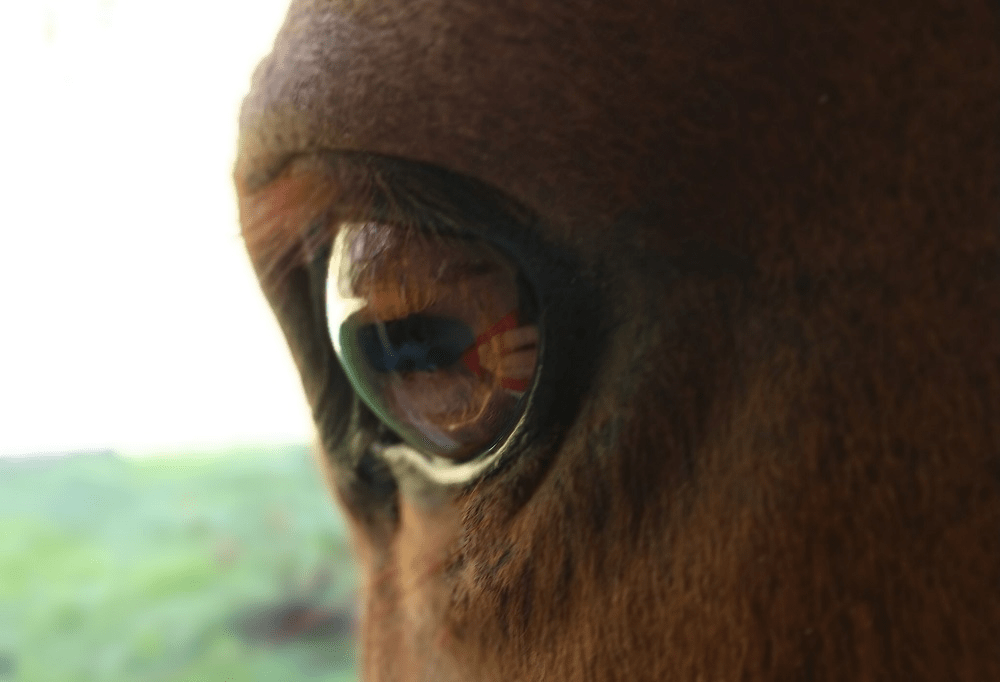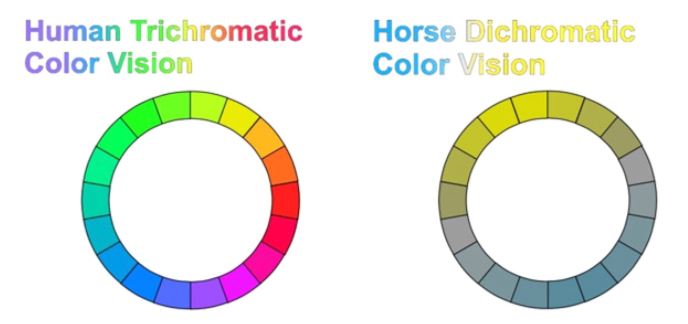Tuesdays with Tony
I get asked all the time about what horses can see. I am a cat of the people. I do as you ask. Okay, not really, but we can pretend. This week I have taken a deep dive into what horses can and can’t see. There’s also a link to a really cool video in this blog. Read on to find it!
The Eyes
To discuss horse vision, we have to start with the basics: the eyeballs. We’ve all got ‘em, but we’re all different. I’ve got pupils that turn into a vertical slit when constricted, and big, huge circles when dilated. You humans are all circles, all the time. It just gets bigger or smaller depending on the amount of light coming in. Horses have a horizontal slit that stays some version of a horizontal oval until they are really, really, really dilated. We’ve also got our eyes in different places on our heads. Cats and humans both have their eyes facing forward. I like to think this denotes us as the superior creatures we are. Horses have them on the side of their head.
Cats and horses share something called a reflective tapetum. This is the bright shiny thing you see when you take pictures of us in the dark, using the flash. What difference does it all make? Well let me tell you, a lot! Cat eyes are designed to get maximum use out of minimum light. When we don’t have properly trained human staff, we are a nocturnal creature. We have to be able to see our prey moving in the pitch black of night. Those vertical slit pupils, combined with forward facing eyes allow us to see movement, and target that movement precisely. The tapetum allows light entering our eyes to reflect back around, allowing us to get more bang per light beam than you humans. Horses can do some of the same things with light, but are generally not as great at seeing in the dark as cats, but better than humans.
What horses do really, really, really well is see movement along the horizon. That’s what that horizontal pupil gets them. Doubt me? How many times has your horse seen what you thought was an imaginary dragon in the woods, only to have a deer wander out? Trust me, they can see movement way better than you and I can. This ability keeps wild horses alive. They have lions and tigers and plastic bags trying to eat them, and those guys know how to stalk! With their eyes on the side of their head, they are able to see that movement almost anywhere on their horizon. What they give up is high level spatial awareness. You and I can judge very closely how near or far we are from an object. Horses can’t do this with vision alone. They need their whiskers, sense of smell, and tactile clues from their limbs to help them know just how close they really are to something.
The Colors
Okay, the color thing is pretty cool. Well, not for horses. They see some pretty boring colors. The differences between horses and humans though, that part is cool. I found this article while perusing the trustworthy side of Google: Google Scholar. It had this handy graphic showing the difference.
Photopigment basis for dichromatic color vision in the horse, Joseph Carrol, et all, Journal of Vision October 2001, Vol.1, 2.
These muted colors help explain why horses don’t worry about that very bright pink thing, but do often take a hard look at black things. Jump course designers will use this to draw a horse’s vision to a black rail or gate, making it easier or harder for the horse to determine what to jump depending on where the black component is placed. It doesn’t explain why they love that particular patch of grass versus another. They must use something other than visual clues there. As a very limited connoisseur of grass, I’m not sure what they use to decide. One of life’s great mysteries.
Miscellaneous horse vision facts
The left and right eye do communicate. Cover your left eye, look at an object. Now cover your right eye. Your left eye wasn’t “surprised” by what it saw, was it? Yeah, it doesn’t work that way for horses either. Yeah, yeah, I know they spook at something they just saw when they see it with the other eye. It’s not because the object is somehow new on this side. It’s because they’re a horse. Actually, it’s probably because of the spatial awareness thing I talked about earlier. Researchers don’t have a concrete answer on this one.
They are slower to adapt to light changes than humans, and way slower than cats. This is why they will sometimes balk at moving from a light area to a dark one. They can’t see. Give them a sec, and things will smooth out.
They really can’t see directly in front of them. They do a pretty great job with the rest of their senses filling in this tiny gap. As you know, nothing stops a horse from finding the treat in your hand!
And finally, the link I promised, which is a really neat video showing what things look like from your horse’s perspective::
https://www.agdaily.com/video/simulation-shows-horse-eye-view/
That was a fun dive into horse vision! I might even admit I enjoyed researching this one. Next time you see my Docs, ask them to show you some of the vision tests we use in horses. It’s not a chart with a large E on it, but it does help them determine how well your horse can see things.
Until next week,
~Tony
P.S. In case you haven’t heard yet, we are having a New Horse Owner Seminar on Facebook Live. It will be happening this Thursday, August 26th at 6:30 PM on our FB page. Be sure to look for the event and click “going” or “interested” to be notified when we go Live!
Tuesdays with Tony is the official blog of Tony the Clinic Cat at Springhill Equine Veterinary Clinic in Newberry, Florida. If you liked this blog, please subscribe below, and share it with your friends on social media! For more information, please call us at (352) 472-1620, visit our website at SpringhillEquine.com, or follow us on Facebook!
[jetpack_subscription_form title="Subscribe to Whinny's Wisdoms"]



